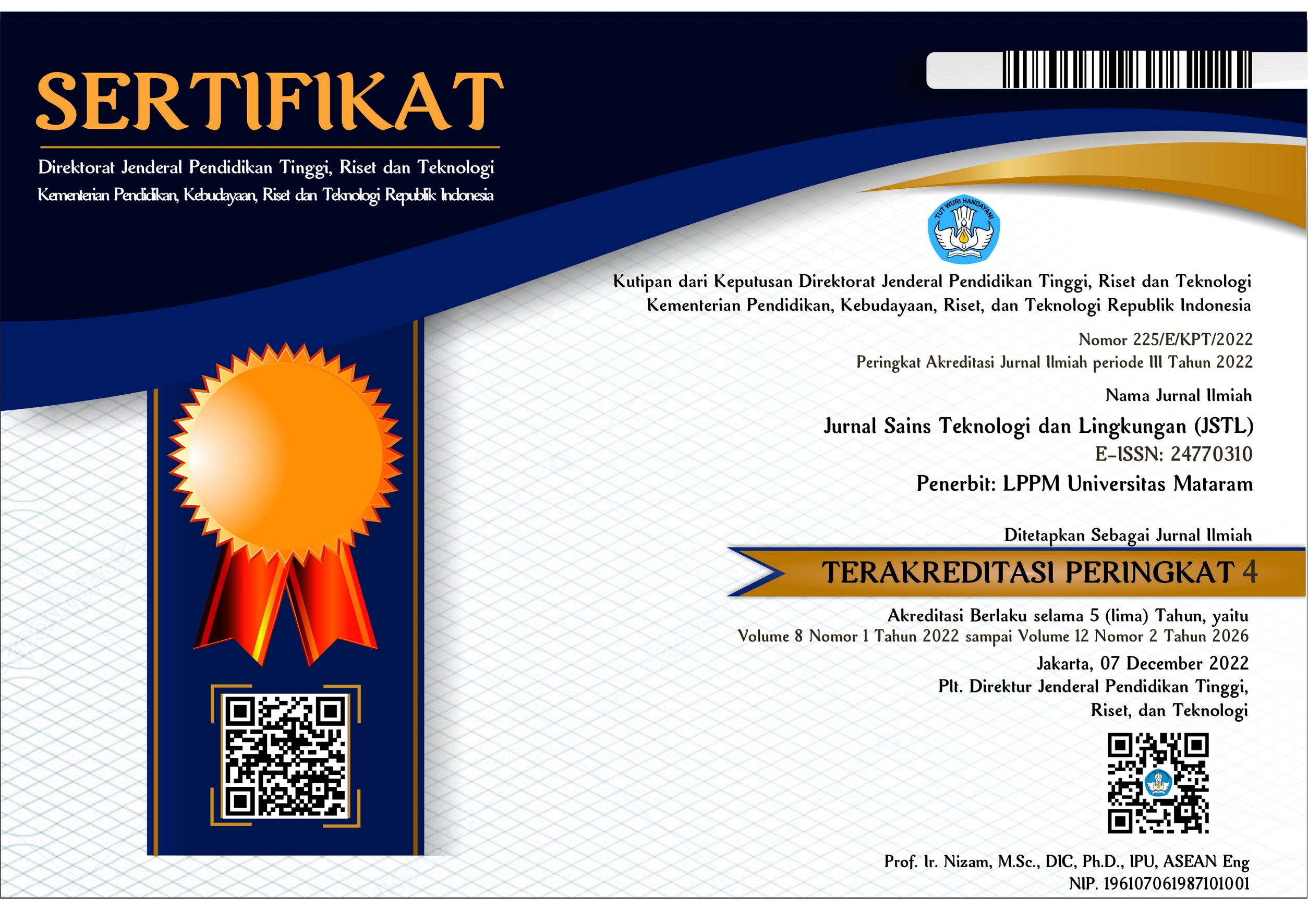Periode Kritis Jagung (Zea mays L.) Berkompetisi dengan Gulma di Lahan Kering
DOI:
https://doi.org/10.29303/jstl.v11i1.858Keywords:
weeds, corn, competition, dry land, critical periodAbstract
Research into the critical phase of weed competition in maize aims to determine weed control at the right time. The study used a randomized block design consisting of eight treatments with weed-free (WWF) and weed-free (WF) plant age periods up to 10, 20, 30, 40, 50, 60, 70, and 80 days after planting (DAP). Each treatment was randomly repeated in three blocks, resulting in 54 experimental units The observation parameters include weed population, dry biomass weight of weeds and maize, plant height, leaf area, ear length, ear diameter and dry weight of maize kernels per plot. Data analysis using analysis of variance and William's statistical test. The results of the study showed that the critical period for corn competition with weeds on dryland was about 20 - 30 DAP when the corn was planted. If weeds are removed after the plants are more than 30 days old, the harvest cannot be saved. Plants competing with weeds for 40, 50, 60, 70, and 80 days experienced yield reductions of 60.32%, 82.84%, 98.66%, 99.99%, and 99.99%, respectively. In contrast, plants that were only weed-free up to the age of 10, 20, and 30 days showed yield losses of 98.66%, 80.16%, and 61.40%, respectively. It is recommended to start controlling corn weeds on dry land 20 days after planting and to avoid weeding 30 days after planting.References
Ahmed, M. B. K. Hayat, Q. Zaman & N. H. Malik. 2011. Contribution of Some Maize Production Factors Towards Grain Yield and Economic Return Under the Agro-Climatic Condition of Dera Ismail Khan. Journal of Biological Sciences 1 (4): 209-211.
Andrew, M. G., Mills, A., Ashley, N. M. D., & Wyand, S. (2022). The importance of species selection in cover crop mixture design. Weed Science, 70(4), 436 – 447. https://doi.org/10.1017/wsc.2022.28
Baraibar, B., Hunter, M. C., Schipanski, M. E., Hamilton, A., & Mortensen, D. A. (2018). Weed suppression in cover crop monocultures and mixtures. Weed Science, 66, 121–133. https://doi.org/10.1017/wsc.2017.59
BPS, 2020. Press Release Angka Ramalan (ARAM) III Produksi Padi, Jagung, dan Kedelai Tahun 2020. Badan Pusat Statistik Indonesia, Jakarta.
Blum, R.R., J. III, Isgris and F.H. Yelfetron. 2000. Purple (Cyperus rotondus) and Yellow Nutsedge (C. esculentus) Control in Bermuda grass (Cynodon dactylon). Journal Weed Technology. 14 (2): 357-365.
Dylan, R. K., Jeanaflor, C. T., & Riechers, D. E. (2023). Inheritance of resistance to S-metolachlor in a waterhemp (Amaranthus tuberculatus) population from central Illinois.Weed Science, 71(6), 549– 556. https://doi.org/10.1017/wsc.2023.63
Ega, A S., Sebayang, H T. & Agung, N. 2018. Pengaruh Waktu Penyiangan pada Tumpang Sari Jagung (Zea mays L.) dan Kacang Tanah (Arachis hypogeae L.). Jurnal Produksi Tanaman 6 (9): 2085-2093.
Ettobong, E. O., Ubulom, P. M. E., & Obot, D. 2020. A Systematic review on Eleucine indica (L.) Geratn.: From athnomedicinal uses to pharmacological activities. Journal of Medicinal Plants Studies. 8(4): 262–274.
Firmansyah, N., Khusrizal, K., Handayani, R. S., Maisura, M., & Baidhawi, B. 2020. Dominansi Gulma Invasif Pada Beberapa Tipe Pemanfaatan Lahan Di Kecamatan Sawang Kabupaten Aceh Utara. Jurnal Agrium. 17(2): 77-86.
John, C., Nader, S., Mariano, G., David, C. H., Darren, E. R., & Peter, H. S. (2022). Interaction between tolpyralate and atrazine for the control of annual weed species in corn. Weed Science, 70(4), 408 – 422. https://doi.org/10.1017/wsc.2022.33
Ngawit, I K. & Farida, N.2022. Potential of Weed as Raw Material for Animal Feed on The Integration of Cattle with Coconut Plantations. Jurnal Penelitian Pendidikan IPA (Journal of Research in Science Education). 8 (Special Issue): 76-86.
Ngawit, I K.& Fauzi, T. 2021. Periode Kritis Jagung Manis Berkompetisi dengan GulmaPada Entosil Lombok Tengah. Jurnal Sains Teknologi & Lingkungan (JSTL). Special Issue (1): 32-43.
Ngawit, I K., Fauzi, T. & Kurnia, M. 2023. Keanekaragaman Gulma Berdaun Lebar dan Prediksi Kehilangan Hasil Tanaman Kedelai (Glycine max L. Merrill.) Akibat Kompetisinya di Lahan Kering. Jurnal Agrokomplek. 2 (2) : 266 – 275.
Nurlaili. 2010. Respon Pertumbuhan Tanaman Jagung (Zea mays L.) dan Gulma terhadap Berbagai Jarak Tanam. Jurnal Agronobios (2) 4: 19-29.
Omid, R. Z., Masoud, H., Mohammad, R. C., Allen, V. B., Reza, K. A., Hamid, R. M., Mostafa, O., & Maryam, S. (2020). Role of cover crops and nicosulfuron dosage on weed control and productivity in corn crop. Weed Science, 68(6), 664–672. Retrieved from https://www.jstor.org/stable/27142984
Pittman, K. B., Barney, J. N., & Flessner, M. L. (2020). Cover crop residue components and their effect on summer annual weed suppression in corn and soybean. Weed Science, 68(3), 301–310. https://doi.org/10.1017/wsc.2020.16
Purwanti, S. Ghaisani, dan Nasrullah. 2012. Penentuan Periode Kritis Cekaman Gulma Pada Kedelai Hitam (Glycine max (L.) Merill). Seminar Nasional Hasil Penelitian Fakultas Pertanian UGM. 11 September 2012.
Sarah, A. D. C., Kim, A. C., Maninder, P. S. & Erin, E. B. (2022). Critical period of weed control in an interseeded system of corn and alfalfa. Weed Science, 70(6), 680-686. https://doi.org/10.1017/wsc.2022.55
Setiawan, D.P., A.S. Karyawati dan H.T. Sebayang. 2014. Pengaruh Pengendalian Gulma pada Tumpangsari Ubi Kayu (Manihot Esculenta L.) dengan Kacang Tanah (Arachis hypogeae L.). Jurnal Produksi Tanaman 2 (3): 239-246.
Rahnavard, A., Z.Y. Ashrafi, A. Rahbari and S. Sadeghi. 2010. Effect of Diffrent Herbicedes on Control of Purple Nutsedge (Cyperus rotondus L.). Journal Weed Science. 16 (1): 57-66.
Wilter, J P., Edison, P. & Eva, S. B. 2017. Periode Kritis Pengendalian Gulma pada Jagung (Zea mays L.). Jurnal Agroekoteknologi FP USU 5 (2): 409-414.
Downloads
Published
Issue
Section
License

This work is licensed under a Creative Commons Attribution-NonCommercial-ShareAlike 4.0 International License.


1.png)











